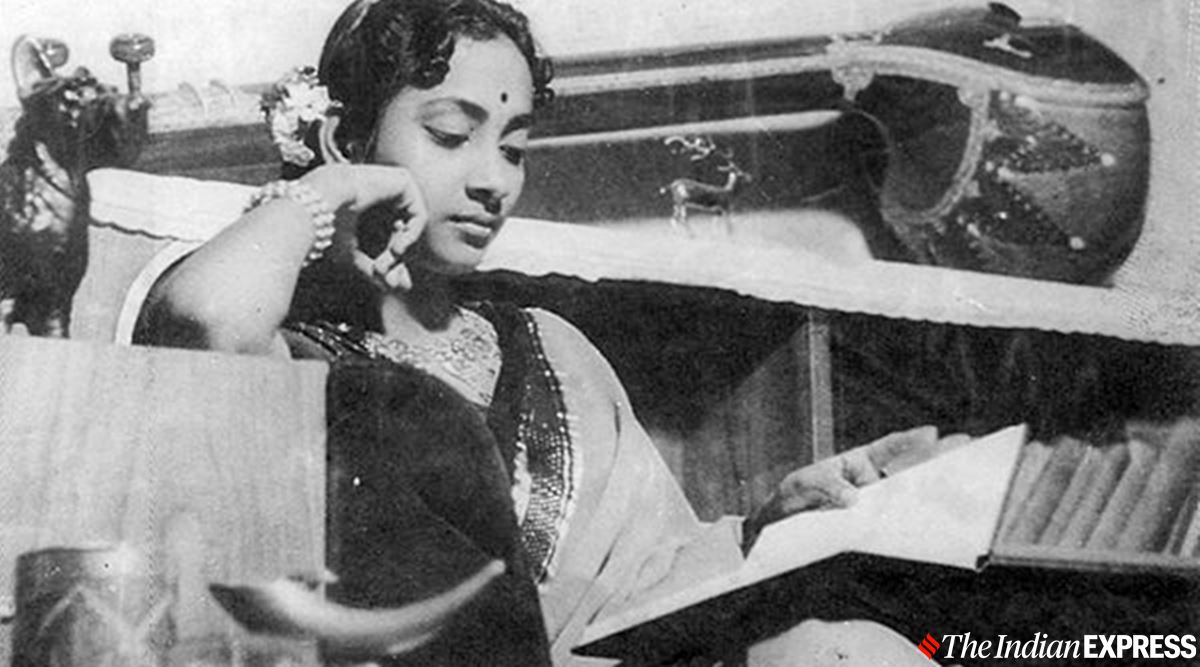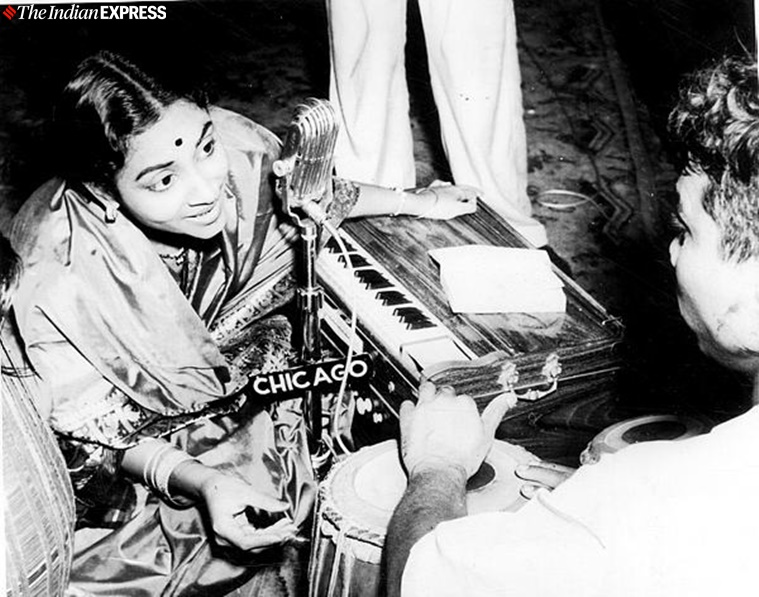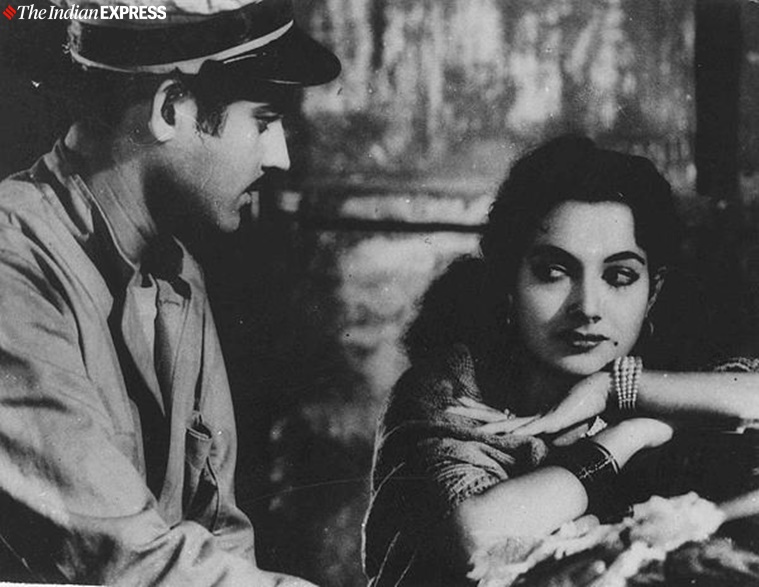 Geeta Dutt enriched our cinema and our lives. (Photo: Express Archive)
Geeta Dutt enriched our cinema and our lives. (Photo: Express Archive) Lata Mangeshkar, Shamshad Begum, Asha Bhosle. These are musical geniuses whose golden voices carry a whiff of Hindi cinema’s golden past. But then, all geniuses need other geniuses to show them who the real genius is. That was Geeta Dutt, one of the greatest lost potentials of all time. For further proof, why not ask Lata Mangeshkar who was the most towering figure of Geeta’s time as well as ours? She will be able to vouch for the fact that Geeta was a rage in her heyday, having dominated Hindi female playback with her soulful style of singing through the high noon of 1950s. How she posed a challenge to Mangeshkar herself and probably, made the Nightingale a better singer in the process. Just imagine the world of Bollywood if Geeta hadn’t died at a relatively young age of 41 in 1972. Imagine only if her husband Guru Dutt hadn’t gone away so soon at 39.
Did we say ‘her husband Guru Dutt?’ That’s right. In a scenario straight out of A Star is Born, Geeta was already the queen of Bollywood playback and a huge commercial success in post-independent India when Guru Dutt was still a big-time struggler trying to make it in the big bad Bombay, a glamorous city of crime and sin that found itself as an important character in his initial directorial hits, such as Baazi, Aar Paar, Mr. & Mrs. ’55 and the best Guru Dutt noir that Guru Dutt didn’t make — C.I.D (helmed by the legendary Raj Khosla and produced by the Master of Misery).
Born into a wealthy landowning family near present-day Dhaka in 1930, Geeta Ghosh Roy Chowdhuri had a talent for singing from a young age, a vocation her parents reportedly encouraged. Only 16 when she started singing for Hindi cinema in 1946, it was within a year of her debut that ‘Mera sundar sapna beet gaya’ from Do Bhai under the direction of SD Burman made her an indisputable star. But listen closely to the poignant lyrics by Raja Mehdi Ali Khan and it seems to echo Geeta’s last years (“Meri prem kahani khatam hui, mere jeevan ka sangeet gaya”), full of regret, separation and loss after her failed marriage and a slide into mental depression. There’s pain in her vocals, belying her callow age.
 Geeta Ghosh Roy Chowdhuri had a talent for singing from a young age. (Photo: Express Archive)
Geeta Ghosh Roy Chowdhuri had a talent for singing from a young age. (Photo: Express Archive) She would go on to strike a formidable partnership with Burman, just as she did with Hemant Kumar and OP Nayyar. All these music legends gave her songs of great emotional depth and romantic yearning, for which her honeyed voice suited perfectly. She sang some of her career’s — and indeed, Hindi cinema’s — best songs for Guru Dutt. Even today, an evening with friends and gathering of old souls is rarely complete without a round of Dutts’ Golden Age touchstones playing on the speaker. ‘Tadbeer se bigdi hui,’ ‘Sun sun sun zalima,’ ‘Babuji dheere chalna,’ ‘Udhar tum haseen ho,’ ‘Waqt ne kiya kya haseen sitam,’ ‘Jaane kya tune kahi’ and ‘Na jao saiyyan chhuda ke baiyan,’ you name it. Guru Dutt was the love of her life but also the reason for her downfall. Despite objections from her family, the couple got married in 1953 when Guru was a budding director — not yet the Dean of Despair. The two masterpieces that we most associate with Guru Dutt, Pyaasa and Kaagaz Ke Phool and also the two other classics that we think of as quintessentially Guru Dutt but was not directed by him, Chaudhvin Ka Chand and Sahib Bibi Aur Ghulam, were still some years away. All four films have at least three figures in common: Abrar Ali, VK Murthy and Waheeda Rehman.
That last name proved to be Geeta’s scourge. She believed her husband was having an affair with the protégé he helped discover and nurture in films like C.I.D, Pyaasa and Kaagaz Ke Phool. In the book Ten Years with Guru Dutt, Abrar Alvi blames Geeta’s “immature behaviour and suspicious nature” for her hubby’s growing closeness with Waheeda Rehman. Although Waheeda has always maintained a stoic silence and never openly talked about her alleged love story, the media has spun its own narrative. More than five decades after his death in 1964 (he had a history of attempted suicides but this time it was an accident, goes the family version), Guru Dutt has become a myth. Geeta, on the other hand, has remained a mystery at best and a curiosity at worst.
Guru Dutt’s films are often lauded for the way he made music an integral part of the plot. Even comic sidekicks (think Johnny Walker) got the meatiest songs. Part of the credit for the hypnotic spell these evergreen songs have cast on music buffs should go to Geeta Dutt, at par with the other key behind-the-scene collaborators like SD Burman, Hemant Kumar, Sahir Ludhianvi, Lata Mangeshkar, Majrooh Sultanpuri, OP Nayyar, Mohammed Rafi and many others.
On her 91st birth anniversary today, here’s a list of five essential Geeta Dutt gems that have enthralled music lovers over the decades, enriching our cinema and our lives.
‘Sun sun sun zalima’ from Aar Paar (1954)
 Guru Dutt and Shakila in Aar Paar. (Photo: Express Archive)
Guru Dutt and Shakila in Aar Paar. (Photo: Express Archive) Guru Dutt is the Bard of Brooding, who’s at his peak when he’s bleak. But in his lighter films and in bouncier roles — usually a trademark of his friend Dev Anand — the auteur appears surprisingly and heartwarmingly natural. In Aar Paar, he plays the street-smart cabbie Kalu who falls “safaa safaa” in love with Nikki (Shyama). But on the night they decide to elope he’s stood up by Nikki. Soon, Kalu is enlisted by the mob and has to prove his innocence to win back his lady love. The film features two versions of ‘Sun sun sun zalima,’ the chirpier first one captures the sweet-nothings of new love followed by the sad tune that articulates Nikki’s heartbreak. Aar Paar’s other enduring musical moment is the groovy club number ‘Babuji dheere chalne’ and though lifted from the Cuban tune ‘Quizás, quizás, quizás’ the Bollywood impression is distinguished by Geeta’s unique voice. From ‘Sun sun’ to ‘Babuji,’ Geeta could effortlessly move between the Westernised and classical, between slow ballads to rambunctious ones. As OP Nayyar once said, she’s an “asset to any music director.”
‘Hum aapki aankhon mein’ from Pyaasa (1957)
Author Yasser Usman reminds us in his book Guru Dutt: An Unfinished Story that this romantic duet, sung by Geeta and Mohammed Rafi, remains the only dream song in any Guru Dutt movie and was included to “provide relief in the midst of a serious story.” Pyaasa is a flawless soundtrack (in Guru Dutt’s most flawless outing). Geeta sang four numbers, most famously for ‘Aaj sajan mohe ang lagalo’ and ‘Jaane kya tune kahi’, both shot on Waheeda Rehman. In an album bristling with such treasures, we urge you to revisit ‘Hum aapki aankhon mein.’ Why? Because its placement in the film is impeccable. It’s the only time in the film when the doomed poet Vijay is shown with a semblance of promise and happiness. Anyone who has seen Pyaasa (bet there are many) will know about Vijay’s progressively worsening misfortunes in a dog-eat-dog social canvas to which he neither belongs nor fits. ‘Hum aapki aankhon mein’ is a short-lived reverie in a tough and trying but ultimately, creative life.
‘Waqt ne kiya kya haseen sitam’ from Kaagaz Ke Phool (1959)
A tormented soul, a suffering and self-destructive artist in a hostile world and a rocky marriage. Guru Dutt’s Kaagaz Ke Phool is said to contain shades of his own life and looks at the superficial nature of celebrity and the ephemerality of fame. Its two immortal compositions (Kaifi Azmi-SD Burman) have become a guiding light for music lovers — the haunting ‘Dekhi zamane ki yaari’ is picturised on Guru who plays the tragic filmmaker Suresh Sinha while ‘Waqt ne kiya kya haseen sitam’ glows in the background as an injured Suresh and his new find (Waheeda Rehman, who’s cast as Paro in Suresh’s dream project, Devdas) inevitably begin an intimate relationship. Shot enigmatically by VK Murthy in black and white, this one’s all about expressions. No lip-synching, no dance movements. Just two souls meeting under the arc lights. It’s a masterclass in conveying unspoken love with furtive glances and wistful longing. As Waheeda put it in Nasreen Munni Kabir’s Conversations with Waheeda Rehman, “My face had to say it all.” If Kaifi Azmi’s words provide the song with its meaning (was Gulzar’s ‘Naam gum jayega’ with lines like ‘waqt ke sitam kum haseen nahin’ influenced by it?) Geeta’s moody voice gives it the soul.
PS: Film fans will know this trivia. One of Amitabh Bachchan’s favourite actresses is Waheeda Rehman, one of his favourite films is Kaagaz Ke Phool and one of his favourite songs is ‘Waqt ne kiya.’ No wonder, Big B instantly agreed to recreate the classic in his booming baritone for 2018’s 102 Not Out.
‘Na jao saiyyan chhuda ke baiyan’ from Sahib Bibi Aur Ghulam (1962)
A slice of the Bengali feudal excess, Sahib Bibi Aur Ghulam explores the decadence that went behind the ornate walls of old havelis of the 19th century aristocracy in Calcutta. Legend has it that Waheeda Rehman had expressed a desire for the role of the melancholic Chhoti Bahu but Meena Kumari was born to play it — and immortalise it. Vinod Mehta in his marvellously readable biography of Meena Kumari writes that Sahib Bibi Aur Ghulam and especially this “unforgettable” song are the first things that come “readily to mind” when audiences think of her. The Tragedienne uses her eloquent poise and poetic cadences to convey the mystique surrounding her iconic character. Composed by Hemant Kumar and penned by Shakeel Badayuni, this melodramatic valentine remains the film’s most timeless memory. As Chhoti Bahu (Kumari) tries to stop her alcoholic and debauched husband (Rehman) from leaving her once again, the track is dipping with shringara rasa. While Meena manages to communicate her character’s inner turmoil through her longing eyes, Geeta masterfully expresses Chhoti Bahu’s burning desire for love and belonging amidst spiritual ruins and a passionless marriage that the young wife finds herself in.
 Geeta Dutt gave us some amazing songs. (Photo: Express Archive)
Geeta Dutt gave us some amazing songs. (Photo: Express Archive) ‘Mujhe jaan na kaho meri jaan’ from Anubhav (1971)
On the face of it, Basu Bhattacharya’s experimental take on ‘marriage’ starring Sanjeev Kumar-Tanuja (first part of his perceptive trilogy) has no need for a song. Yet, composer Kanu Roy and lyricist Gulzar give Geeta Dutt one of her swan songs in ‘Mujhe jaan na kaho meri jaan’ for which Roy tones down the instruments to its barest minimum, allowing Geeta’s voice the quiet freedom and noise-cancelling subtlety it deserves. Romantic, tender and visually arresting, it drops at a crucial point in the movie — just when the protagonists Amar-Meeta are rekindling their lost conjugal bliss. Bumps lay ahead thanks to an unlikely third wheel (Dinesh Thakur) but for now, they can enjoy their togetherness under the watchful gaze of family servant Hari (AK Hangal). Immediately after this song, Amar, soaked thoroughly in rain, comes down with a fever. As for the listeners, they might call in sick, too — blame it on the ‘Geeta Dutt Fever.’
- The Indian Express website has been rated GREEN for its credibility and trustworthiness by Newsguard, a global service that rates news sources for their journalistic standards.

